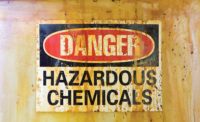Analyze chemical storage, human error & natural disasters

When there is a possibility that a large chemical spill could necessitate evacuating employees, establishing isolation zones, communicating with several different entities and coordinating response efforts with outside resources, it pays to be prepared. Having a comprehensive response plan, tools and well-trained employers are keys to keeping a bad day from becoming worse.
Being prepared for emergency spills isn’t just about avoiding a potential fine for failing to have a plan. Facilities that have plans and whose employees know how to follow those plans are better able to safely handle those spills, minimize downtime and reduce environmental impact.
Assess risks
Accurate chemical inventories play an important role in compliance with several different regulations, from OSHA’s Hazard Communication Standard to EPA’s reporting requirements under the Superfund Amendments and Reauthorization Act (SARA). Knowing the volumes of hazardous chemicals and where each of them is stored onsite also helps to assess the potential for a spill of any of those chemicals to create an emergency.
Process interruptions, the age and condition of chemical storage containers and human error are all common causes of chemical spills, but external factors that are beyond the control of anyone at the facility must be considered as well. Natural disasters such as earthquakes, hurricanes and flooding, as well as acts of vandalism and terrorism should all be considered when creating plans.
Job hazard analysis (JHAs) and other existing safety or environmental plans may also provide information on chemical risks and how they may affect not only the facility, but also the surrounding community. In most areas, the local emergency management agency is an additional resource that can provide facilities with support in assessing risks and creating response plans.
Have a plan
A familiar adage among first responders says “if you fail to plan, you plan to fail.” Facilities that have inadequate plans, or worse: no plans, create unsafe conditions for their employees and communities. Chemical spills are always inconvenient. The first moments following a spill can also be very chaotic, and without plans, a lot more can go wrong.
Both OSHA and EPA recognize the need for facilities to be prepared for chemical spill emergencies and require facilities to have plans that address how they will respond to spill scenarios. In many cases, plans must also document the tools and supplies that the facility has onsite for response as well as employee training and coordination with local outside resources such as fire departments, emergency management offices and hospitals. Even if the facility chooses that their only response to a chemical spills will be for employees to pull an alarm and evacuate the building, that needs to be documented as the facility’s plan.
Stocking response supplies
Although facilities need to have plans and be prepared for spills, there is no pre-prescribed list of materials that must be kept on hand to respond to a spill. This allows facilities to choose the tools and products that make the most sense for their particular situations.
At some facilities, spills may be diverted to floor drains that lead to an onsite water treatment facility where it can be neutralized or otherwise handled. For others, spills may be contained and absorbed using absorbent mats, socks and booms. Still other facilities may use vacuums and pumps to recover spilled liquids so that they can be reused or recycled.
Regular inspections
Because spill response supplies are stored in convenient locations, it is far too common for these materials to be “borrowed” for everyday use. Empty spill kits and missing response tools are frustrating and will delay spill response efforts.
To make sure that spill response supplies will be available when and where they are needed, consider adding them to weekly or monthly safety inspection forms. One way to facilitate inspections without having someone physically check inventories is to put tamper-evident labels or inexpensive cable ties on the kit, locker or cabinet containing response tools.
Spill response supplies, especially personal protective equipment, can break down over time. So, in addition to weekly or monthly inspections that verify that response tools are available, all supplies should be checked at least annually to verify that everything is still viable and in working condition. Some facilities perform this audit as part of their annual spill response drill.
Employee training and drills
Every employee needs to be taught what to do when there is an emergency spill. Even if their only role is to evacuate the building and go to a pre-designated area, they need to know what route to take and where they need to assemble after they are safely out of the building. Training helps these employees, as well as those who will be more involved in responding to a spill, know their roles and responsibilities so that they can perform them safely and effectively.
Employees who will take an active role in containing and controlling an emergency spill need to have the appropriate level of training under OSHA’s Hazardous Waste Operations and Emergency Response (HAZWOPER) Regulation [29 CFR 1910.120.] This standard outlines levels of knowledge that employees must be able to demonstrate to help ensure that they will be able to perform their response roles safely.
Regular drills and exercises allow everyone to practice their roles and become familiar with response tools and personal protective equipment. Involving local fire departments, hazmat teams, hospitals and police will help those entities become familiar with your facility and your response plans.
With the exception of drills, most facilities don’t plan on having spills. They’re unplanned, unexpected and disruptive. Facilities with plans are better prepared to handle them safely and effectively, minimizing downtime for the facility as well as environmental impact.
Looking for a reprint of this article?
From high-res PDFs to custom plaques, order your copy today!






